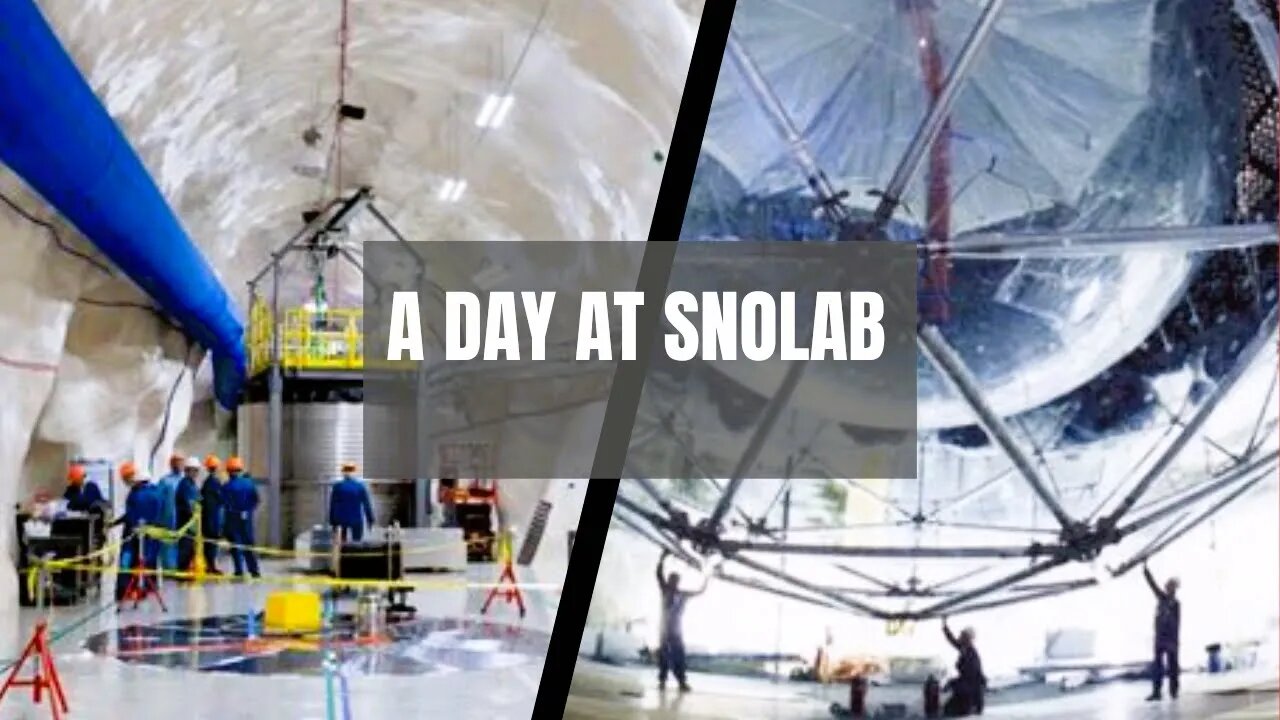Premium Only Content

A Day at SNOLAB- Deep Underground Dark Matter Detection & Neutrinos Laboratory
SNOLAB is located on the traditional territory of the Robinson-Huron Treaty of 1850, shared by the Indigenous people of the surrounding Atikameksheng Anishnawbek First Nation as part of the larger Anishinabek Nation.
We acknowledge those who came before us and honour those who are the caretakers of this land and the waters.
SNOLAB is Canada’s deep underground research laboratory, located in Vale’s Creighton mine near Sudbury, Ontario Canada.
It provides an ideal low background environment for the study of extremely rare physical interactions. SNOLAB’s science program focuses on astroparticle physics, specifically neutrino and dark matter studies, though its unique location is also well-suited to biology and geology experiments. SNOLAB facilitates world-class research, trains highly qualified personnel, and inspires the next generation of scientists.
At 2km, SNOLAB is the deepest cleanest lab in the world. It is an expansion of the facilities constructed for the Sudbury Neutrino Observatory (SNO) solar neutrino experiment and has 5,000 m2 of clean space underground for experiments and supporting infrastructure. A staff of over 100 support the science, providing business processes, engineering design, construction, installation, technical support, and operations. SNOLAB research scientists provide expert and local support to the experiments and undertake research in their own right as members of experimental collaborations.
History of SNOLAB
From 1970 to 1994, there was another underground neutrino detector set up in a mine in South Dakota. The Homestake experiment, a brainchild of Dr. Ray Davis, was set up to measure neutrinos from the Sun. The data collected presented a problem: the detector measured only about a third the number of neutrinos predicted by theorists. The experiment appeared to be sound, so what was going on? Physicists were concerned there may be fundamental flaws in the Standard Model, something wrong with our entire understanding of physics. There was even a possibility the diminished neutrino output was a sign that the Sun was actually going out (because of electromagnetic interactions light takes much longer to escape the Sun than neutrinos, so this was a valid concern).
The SNO experiment was designed to address this question, dubbed by physicists ‘The Solar Neutrino Problem’. Scientists knew that neutrinos came in three flavours: electron, muon, and tau. Up until this point, it was assumed that they did not change flavour. The Homestake experiment was sensitive only to electron neutrinos, the flavour produced in the Sun. SNO was designed to be sensitive to all three flavours of neutrino. Years of data from the SNO experiment found that in fact the Sun was creating the expected number of neutrinos, but they were changing flavour on their journey to Earth, so the Homestake experiment missed some of them. This finding was corroborated by the Super-Kamiokande detector in Japan, and the 2015 Nobel Prize in physics was awarded to Dr. Art McDonald of SNO and Dr. Takaki Kajita of Super-K.
The success of SNO and a strong working relationship with Inco (later Vale) meant plans to expand the lab were already in the works as SNO was still collecting data. The SNOLAB expansion added an additional 6,300 m2 of excavations, of which 3,700 m2 is clean room space, attached to the existing facility. The clean/dirty boundary was moved for the expanded laboratory and some existing excavations were converted to additional clean space. SNOLAB construction took place in two phases. Phase I added a new laboratory entrance and service facilities (chiller, generator, wastewater treatment), and new experimental areas: a network of drifts (Ladder Labs) for small and medium sized experiments and a large experimental hall (the Cube Hall) for a bigger experiment. Phase II consisted of an additional larger experimental space dubbed the Cryopit which is designed for an experiment using a large volume of cryogenic liquid and is isolated from the rest of the laboratory for safety in the event of a cryogen leak. In addition to the new laboratory space, there is also the existing SNO cavern and its associated Utility Drift and control room.
SNOLAB was constructed using capital funds totalling $70M, including an initial $38.9M capital award from the Canada Foundation for Innovation through the International Joint Venture program. The Ontario Innovation Trust, the Northern Ontario Heritage Fund, and FedNor provided additional funds enabling construction.
-
 LIVE
LIVE
LFA TV
22 hours agoTIME FOR PAYBACK! | LIVE FROM AMERICA 2.24.25 11AM
4,998 watching -
![🔴[LIVE TRADING] Bounce or Bust?! || The MK Show](https://1a-1791.com/video/fwe2/ad/s8/1/c/n/q/f/cnqfy.0kob-small-The-MK-Show-Feb.-24th.jpg) LIVE
LIVE
Matt Kohrs
15 hours ago🔴[LIVE TRADING] Bounce or Bust?! || The MK Show
674 watching -
 1:03:25
1:03:25
Kyle Fortch
3 hours agoRick Barker: Managing & Developing Taylor Swift, Breaking Artists Today & MORE | THE ONE SHEET S1E5
2 -
 37:11
37:11
BonginoReport
6 hours agoDan Bongino is Leaving (Ep.146) - 02/24/2025
145K378 -
 2:59:20
2:59:20
Wendy Bell Radio
7 hours agoThe MAGA Diet
71.2K38 -
 1:22:03
1:22:03
Graham Allen
4 hours agoGRAHAM MAKES YUGE ANNOUNCEMENT!! + LIBERAL REP ROOTING AGAINST AMERICA?!
50.5K50 -
 1:01:28
1:01:28
Randi Hipper
3 hours agoETHEREUM PRICE BOUNCES AFTER BILLION DOLLAR HACK!
33.4K1 -
![Massive Paradigm Shift: Bongino Hired At FBI; Joy Reid Fired At MSBNC [EP 4450-8AM]](https://1a-1791.com/video/fwe1/52/s8/1/u/2/_/e/u2_ey.0kob-small-Massive-Paradigm-Shift-Bong.jpg)
The Pete Santilli Show
17 hours agoMassive Paradigm Shift: Bongino Hired At FBI; Joy Reid Fired At MSBNC [EP 4450-8AM]
206K18 -
 1:27:17
1:27:17
Game On!
16 hours ago $3.13 earnedAnother Monday without football...
36.8K8 -
 1:43:56
1:43:56
Jeff Ahern
4 hours ago $5.72 earnedMonday Madness with Jeff Ahern (Ding Dong the Witch is Gone!)
74.7K3